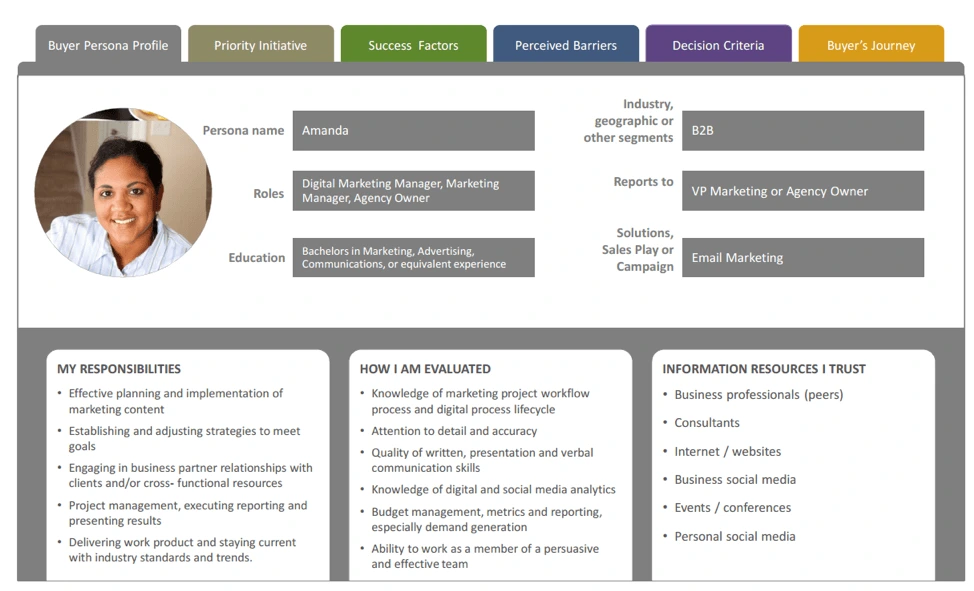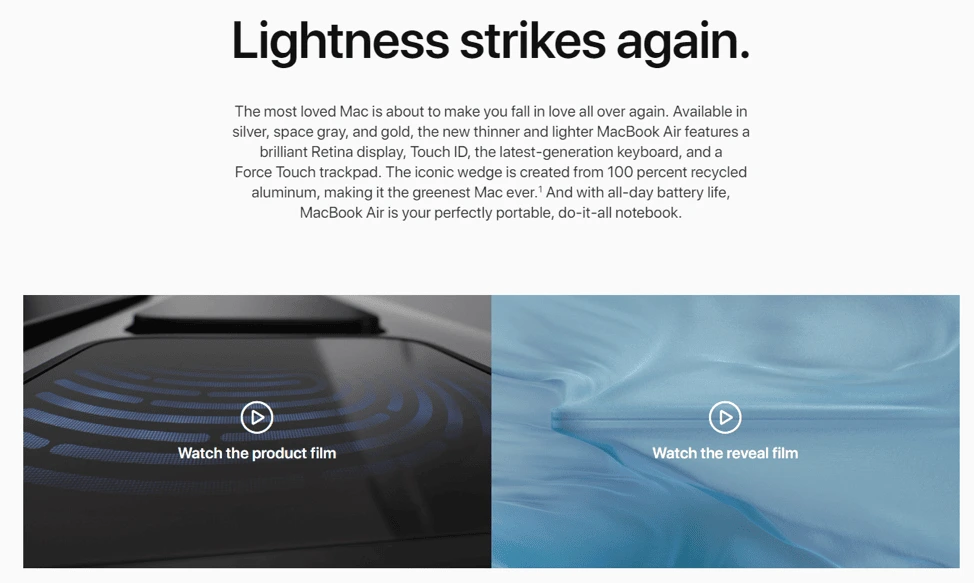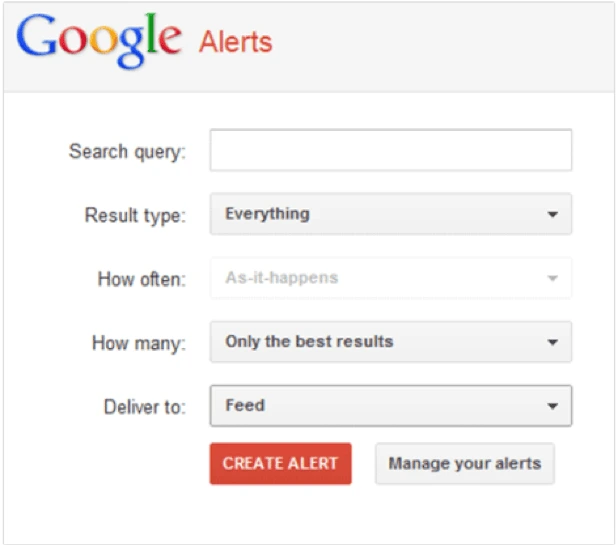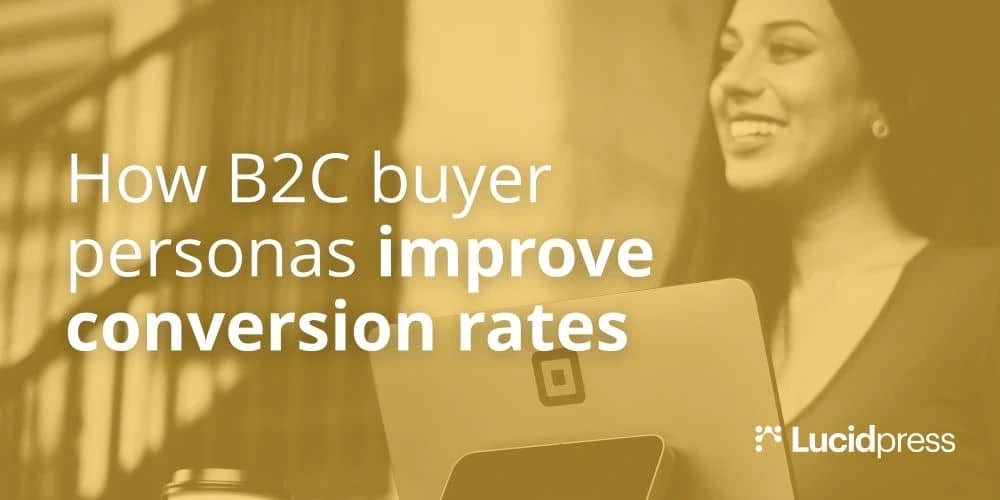Have you ever worried that your brand messaging is a bit… generic? Does your copy sound flat and uninteresting? Do customers feel like your brand is speaking at them, not to them?
These are questions many brands grapple with on a daily basis. Some focus so much on pleasing everyone that they end up pleasing no one. Either way, the results are a tired brand and conversion rates that hit new troughs every week.
Related: How to create a voice for your brand
As any seasoned copywriter will tell you, it’s much easier to convince a single person to choose your brand than to convince a large group. By personalizing your campaigns, you add intimacy, authenticity and trust—vital ingredients for improving conversion rates.
To personalize effectively, however, you first need to understand who your buyers are. The best way to do that is to create buyer personas.
In this guide, I’ll show you why buyer personas matter for B2C brands and how to make them.
Buyer personas: Not just for B2B marketing
What does your ideal customer look like? What websites do they frequent the most? What are their likes and dislikes?
A buyer persona helps you answer these questions and more. Think of it as a fictional portrait of a specific customer that helps you understand their mindset and create better targeted campaigns.
What is a buyer persona?A buyer persona is a fictional portrait of a specific customer that helps you understand their mindset and create better targeted campaigns.[]
This specific customer doesn’t actually exist. Rather, they represent an entire consumer group. If your brand targets men aged 25-35, for instance, your buyer persona might focus on a 28-year-old single male who works in finance and enjoys playing video games.
Essentially, you create buyer personas so you can create campaigns that are more relevant and personalized. Instead of speaking to everyone’s concerns, you can tailor your messaging to address the concerns of a specific group.
This sample persona from the Buyer Persona Institute should give you a good idea of what we mean:

Your buyer personas should target customers who:
- want to buy your products, i.e. have clearly expressed a need and desire to buy from you.
- would buy your products, i.e. are a good fit based on their demographics & psychographics but need to be educated about the product first.
How many buyer personas you’ll have is up to you. A new startup with a single product might have just one buyer persona. A huge corporation like Microsoft might have dozens—even hundreds!—of personas.
How better buyer personas impact conversion rates
Have you ever landed on a website and felt that it spoke just to you? That it mirrored the values you believe in and addressed the exact problem you hoped to solve?
This likely wasn’t an accident; it was probably the result of meticulous buyer persona research.
While there are many ways to improve conversion rates—storytelling, design choices and website speed, to name a few—much of it eventually boils down to the same thing: the clarity of your messaging. When you can identify your customers’ deepest desires and address them directly, you won’t suffer from low conversion rates (and you won’t have to depend on design hacks to save you).
Take Apple’s MacBook Air landing page as an example.

Right away, the copy addresses all the things MacBook Air customers care about:
- Low weight (“Lightness strikes again”)
- New features, especially Retina display
- Environmentally friendly design (“recycled aluminum”)
- Portability and battery life
The repeated use of “again” calls out to current MacBook users, using a bit of nostalgia to entice them to upgrade.
Without a detailed buyer persona, it would’ve been difficult for Apple’s copywriters to know which features to highlight and which to ignore.
This is the true value buyer personas bring to conversion rate optimization. By changing your copy to focus on the things your target audience cares about, you can achieve significantly better conversion rates.
Moreover, accurate personas help you understand your customers’ preferences, from the language & writing style to the visual elements.
If you have detailed buyer personas, you can create personalized landing pages (which convert better) and offer better recommendations to customers.
The question now is: How exactly do you go about creating these buyer personas? I’ll share some ideas below.
Gathering the information
A strong buyer persona is based on data & insight from market research. This first-hand information reveals demographic & psychographic information about your customers.
There are a variety of strategies you can use to collect this information, and here are a few examples.
1. Run surveys
Hosting surveys is a good way to gather information right from the source.
You can either run a survey on your existing customer base or place a pop-up survey on your website for visitors to participate in.
Make sure that you have a large-enough sample size for the data to be accurate. Don’t over-rely on survey results—self-reported data tends to be biased.
You can use software such as Qualtrics, SurveyMonkey or Qualaroo to help you create a survey.
Additionally, consider reaching out to your customer support & sales teams for insight, since they interact with customers on a daily basis.
2. Use your competitors’ data
If you don’t have a large customer base or heavy traffic on your site, you can look to your closest competition.
For example, you might use Google Alerts to know each time your competitor is mentioned online and analyze the source.

When any mentions pop up, ask yourself:
- Who is writing about my competitor?
- Which other topics, products and issues do they write about?
- What are the demographics of the audience leaving comments or sharing the article?
You can also visit your competitors’ Facebook, Instagram & Twitter pages to see how people interact with their brand (and what those people are like). Pay particular attention to their geographic location, ages and shared interests.
This kind of research is often subjective, but it can still give you a good indication of your competitors’ audiences.
3. Hang out where your customers are
Put yourself in the shoes of your ideal customer.
Hang out where they do and listen to what’s being said. It’s a direct way to discover insights about the language they use and the challenges they face.
You can also read through comments on blogs, hang out on forums, or even attend in-person trade shows and events.
For example, if you’re an athletic shoe brand, you might use Reddit’s search feature to find questions potential customers are asking about running shoes. This can help you zoom in on the problems these customers face and how to address them in your messaging.

Bring your buyer persona to life
Now that you’ve gathered the data, it’s time to make sense of it and bring your ideal customer to life.
Buyer personas are open-ended in terms of what you can or can’t include in them. Virtually anything that helps you understand the customer better is fair game. This includes everything from the customer’s (fictional) background & education to their favorite movies & brands.
Since you’re targeting B2C customers, you can let go of some B2B buyer persona conventions such as including the customer’s title & job duties.
That said, there are a few things every buyer persona should have:
- Name. Give your ideal customer a name to humanize them and make them easier to reference. This can be a first name or a full name; the choice is yours.
- Demographic information. Include basic demographic information about the customer, including their age, location and gender.
- Education level. The complexity of your copy and the features you choose to highlight will often depend on how educated your customers are.
- Background. Create a background story for the buyer. If they already know about your brand, explain how they came to find you.
- Psychographic information. What does the customer like? What do they dislike? Psychographic data can reveal a great deal about your customers, so pay special attention to this section.
- Motivations & values. What motivates your ideal customer? What do they want—from life, from work and from your brand? If you’re a value-based brand, what values will you highlight to appeal to them?
- Picture. Although it’s optional, putting a face to the buyer makes it much easier to visualize them and relate to their problems.
Bring it all together into a single Lucidpress document. You can keep it text-heavy or use a visual design—it’s up to you. For reference, check out this sample buyer persona:

Source: Shopify
Key takeaways
Creating buyer personas helps you speak directly to your customers.
By knowing the traits, values and priorities of your customers, you can craft personalized messaging that feels more relevant to them. The results are highly targeted campaigns with higher conversion rates.
Try it yourself by gathering data on your customers and summarizing it in a well-designed Lucidpress document.



